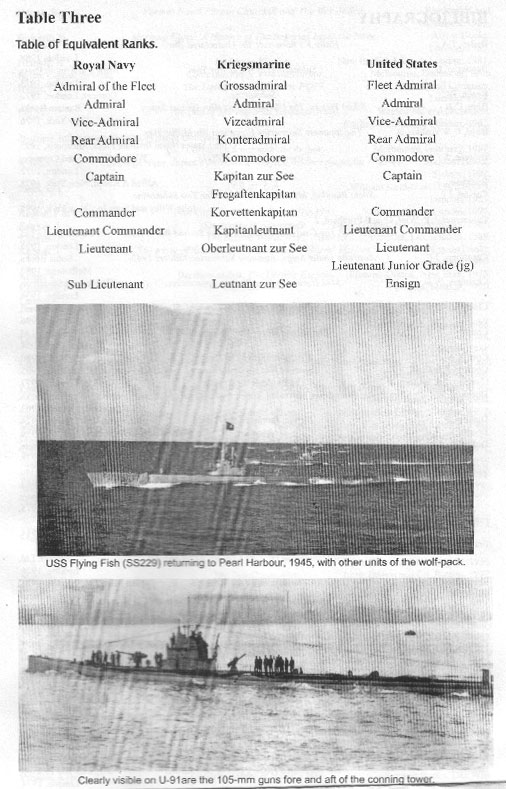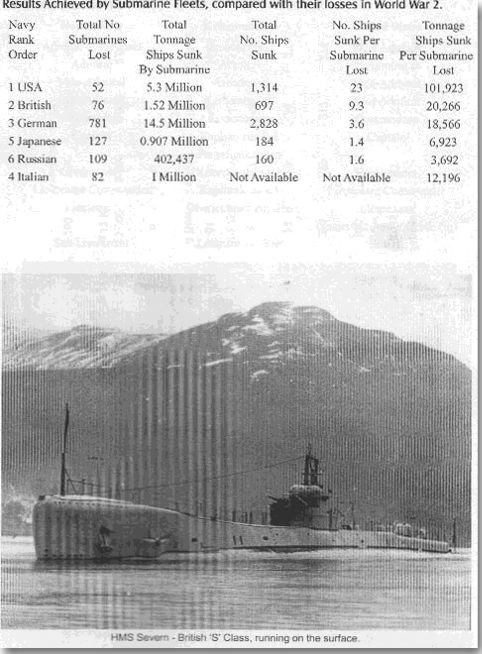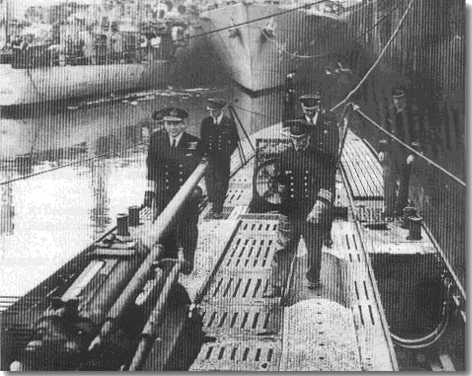|
Submarine Fleets over the 1939-1945 War.
( a ) Germany.
The number of recorded U-Boats sunk, or captured, over the course of the war vary, depending on the source of one's statistics, but this figure varies only slightly from 781 to 785.
The U-Boats wreaked havoc on Allied Shipping, sinking 14,500,000 tons over all the oceans of the world. Out of this total, some 11,904,954 tons was sunk in the North Atlantic alone. Although the U-Boats were eventually fitted with "Schnorchel" allowing them to charge their batteries, whilst breathing below the surface, thus making them harder to find, over June to December 1944, 140 Boats did not return to their bases. The U-Boat Command paid a huge price in the loss of their personnel, of 40,900 Officers and Men involved, 25,870 were killed ( 63% ) and another 5,338 taken Prisoner of War.
( b ) British.
The British lost 75 Submarines, and their under water Fleet sank 1,520,000 tons of Merchant Shipping, and 169 Warships in all theatres.
The British Merchant Navy had very heavy casualities, they lost 30,248 men, whilst the Royal Navy had incredible losses- 73,642 during the war, most of these in the North Atlantic. In addition, in the Royal Canadian Navy, those paying the ultimate price, numbered 1,965 men. Coastal Command losses need to be added to this side of the equation too, and they added up to another 5,866 Men, and 1,777 Aircraft.
RAF Coastal Command Aircraft flew 120,000 sorties, taking 850,000 hours, and they flew 100 Million miles.

( c ) Japan.
Japan started the war with 63 operational Boats, 48 I Class, or large Submarines, and 15 of the smaller RO Class, and they had another 29 Boats under construction, but not yet completed.
In all, 126 Submarines were built during the war, and 56 remained at the surrender. Most were inoperable through lack of maintenance or damage sustained at sea. 127* Japanese Submarines ( excluding Midgets ) were lost in the Pacific War- 70 to Ships, 19 to enemy Submarines, 18 to Aircraft, and the balance to miscellaneous causes.
* A number of sources put the Japanese Submarine losses as high as 131, but in correspondence I had with the Japanese Defence Attache, Captain T. Yamamoto
dated the 9th. of April 1997, he placed the figure at 127. ( See his letter on an earlier page. )
To quote Polmar, from his Submarines of the Imperial Japanese Navy 1904-1945.
"The traditional application of Submarines in the Japanese Navy was to operate in Fleet warfare. Therefore, the Cruiser type Submarines were developed to participate in lengthy Cruiser operations, the Fleet type to accompany the Battle Fleet, and the
medium size for use in Coastal defence."
Polmar also notes " Toward the end of the war, as a trump card for the defence of the Japanese homeland, the smaller size, special attack Midget Submarine, and the Kaiten
human Torpedoes were massed produced, but the war ended before they could be
effectively employed."
And finally, Polmar commented: " So devastating was the Anti-Submarine warfare, that, when the conflict ended, there were only nine large attack Submarines still in service."
Japanese Submarines accounted for about 184 Merchant Ships with a tonnage of 907,000 tons. This included 98 US Ships of 520,000 tons. ( See Captain Yamamoto's letter on an earlier page. )
In addition, they sank two Aircraft Carriers, two Cruisers, and ten Destroyers.
In Hashimoto's book: Sunk. The Story of the Japanese Submarine Fleet. 1942-1945,"
he notes: " The Japanese Submarine Fleet was entirely wiped out, but the Martial spirit of its' Sailors is still with us on the far flung oceans. In the Pacific, the Indian Ocean, and the Atlantic, we remember the multitude of resentful sleeping warriors. In
our ears we hear the whisper of the Voices from the Bottom of the Sea."
The operation of Japan's Submarine Fleet was, in general, disastrous. Crews and Boats were sacrificed through poor planning, and the lack of suitable and efficient Radar.
( d ) Russia.
Russia commenced the war with 218 Submarines, added another 54, but lost a total of 109 Boats.
Like Japan, Russian Submarines had only limited success, and in the case of the Russian Submarines, their kills were in no way commensurate to the loss of 109 Boats. They sank only 160 Ships, many of them small, to total but 41,203 tons, and their operation was restricted to the Baltic and the Black Sea areas.
However, the largest loss of life accredited to any one Submarine attack goes to a Soviet Submarine, S13. It was on the 30th. of January 1945, that the German
Wilhelm Gustloff, of 25,484 tons, was being used as a refugee transport evacuating German troops trying to escape from the Red Army advance, ( between the 23rd. of January and the 8th. of May 1945, liners carried over two Million troops from the Baltic to West German ports. )
Wilhelm Gustloff had 8,000 people jammed on board, this cargo included troops, wounded, and some civilians. Her company at this time, was four times her normal peace time capacity. The Soviet Submarine sighted the ship, lined her up, and fired. Three torpedoes struck home, only 1,000 survived, leaving the approximate number who died at 7,000. These figures equate with the loss in Lusitania, multiplied six fold, this action became the worst single disaster in Maritime History.
( e ) Italy.
When Italy declared war on Britain in June 1940, she had about 115 Submarines, although on the 11th. of March 1940, Mussolini told Rippentrop that 120 Italian Submarines would be ready the following May ( the Ciano Diplomatic Papers, 1949.) But then, Mussoloni was never really noted for his veracity.
Italy's Submarine operations were generally limited to the Mediterranean, although very limited numbers did get out to operate in the Atlantic, the Red and Black Seas. Some 82 Italian Submarines were sunk during their wartime activities. This figure has been cited as 85, but from correspondence I had with the Italian Defence
Department in Rome, I have used the figure of 82. The statistical data they sent me, something in excess of 30 pages, was all in Italian, I am grateful to Henri Conway, President of the Heidelberg Sub Branch of the Naval Association of Australia, he arranged for a member of the local Italian Naval Association to translate into English the major headings used for the Submarine name, place and date of its' sinking, etc.
A further ten were disarmed, and another six put out of action. Tonnage sunk by Italian Submarines is difficult to document with finality, but, from the Total Warship and Merchant Ship sinkings at August of 1942, I estimate these figures to be in the vicinity of a 1,000,000 tons.
Admiral Donitz was quite scathing about the Italian's lack of results emanating from their Submarines deployed in the Atlantic Ocean.

( e ) United States.
The US Submarine Fleet after Pearl Harbor entered their war, with 111 Boats in commission, 51 in the Pacific, ( 29 at Manila, and 22 at Pearl Harbor, ) a further 73 were under construction.
The Japanese Merchant Fleet was decimated by Allied Submarines, ( British and Dutch Submarines operating in the Pacific, accounted for 29 ships of 65,000 tons, and 10 ships of 42,000 tons respectively. )
Although the US Submarine arm claimed 10 million tons of Japanese shipping sunk, made up from 4,000 vessels. Post war estimates were just over half of the claimed tonnage sunk, and ship numbers were closer to 33% of those claimed.
I have already commented on the defective American Torpedo in the earlier part of the Pacific war, but US Submarines fired 14,748 Torpedoes at their targets, something in excess of 11 torpedoes for each ship sunk. Many missed their mark, and subsequently were wasted. In the case of HMAS Canberra, it would seem from Bruce Loxton's book: The Shame of Savo, we picked up a friendly torpedo which was fired by our starboard screening destroyer, USS Bagley.
The American Submarine service enjoyed the greatest success of all Submarines
operated by either Allied or Enemy Navies in WW2, they sank about five times the tonnage that Japanese Submarines achieved. They lost 52 Boats, ( two of them in the Atlantic ) the least number of Submarines lost of any Navy involved in the Second World War.
However, comment must be made, that the United States Submarines operating against the Japanese Navy, were faced with the most inefficient Anti-Submarine force facing the Allies, by complete contrast, the German U-Boat was always up
against the most efficient and determined Anti-Submarine Fleet afloat, the Royal Navy.
The American Submarine Operational History concedes:
"It would do very well for all Submariners to humbly ponder the fact that Japanese
Anti-Submarione defences were not the best. If our Submarines had been confronted with Allied Anti-Submarine measures, the casualty list of the Submarine force would have been much larger, and the accomplishment of Allied Submarines less impressive."
US Submarine skippers were all Anapolis graduates, and the quality of enlisted personnel serving in Submarines was so high, that almost 50% of them had become Officers by war's end.
However, many US Submarine Captains did not stand up to the rigors of war that was demanded of them. 30% in 1942 were removed for lack of fitness or lack of results, and 14% for the same reason in both 1943 and 1944.
Although the US Submarine force made up but 2% of the United States Navy, it accounted for 55% of all Japanese Maritime losses. But this arm of the Navy paid a very high price for their success. Out of a total of 16,000 Submariners, 375 Officers and 3,131 Enlisted men died at sea. This was a 22% casualty rating, the highest % of all the United States Armed forces.
It must be said, that the American Submarines in the Pacific, with the limited help of a few British and Dutch Boats, played a major role in the defeat of Japan. They absolutely decimated that country's Merchant Fleet, choking off essential supplies, above all oil, and prevented the Japanese people from continuing their support of the war effort.
The following figures illustrate this point most starkly:
Japanese Ocean Going Vessels:
|
Tonnage |
|
Cause of Losses |
% |
|
|
|
|
|
| At December 1941. |
5,900,000 |
|
1. Submarines. |
54.7 |
| Built during war. |
4,100,000 |
|
2. Aircraft. |
30.9 |
|
10,000,000 |
|
3. Mines + Other |
14.4 |
|
|
|
|
|
| Sunk. |
8,617,000 |
|
|
|
| Heavily Damaged |
937,000 |
|
|
|
| - Total Losses |
9,554,000 |
|
|
|

The War with Japan is finally over.
Finally, after the dropping of two Atomic Bombs, Japan, " UNCONDITIONALLY SURRENDERED, on board Admiral Bull Halsey's Flag and Battleship, USS Missouri, on the 2nd. of September 1945.
At that moment in history, I was fortunate to be present in Tokyo Bay, serving in HMAS Shropshire as a Lieutenant RAN.
General Douglas MacArthur, in stage managing the surrender proceedings declared:
"It is my earnest hope, indeed the hope of all Mankind, that from this solemn occasion a better world shall emerge out of the blood and carnage of the past, a world founded upon faith and understanding, a world dedicated to the dignity of man and the fulfilment of his most cherished wish, for freedom, tolerence, and justice,"
The multitude of signatures were collected on the surrender documents, and Warfare in general, and by Submarine Warfare in particular.
The enormous loss of human life and materiel bears witness to the efficiency of the Submarine as a very potent weapon of destruction.
Walter Lipman in his The Public Philosophy comments:
"Men have been barbarians much longer than they have been civilized, and within us there is a propensity, persistent as the force of gravity, to revert under stress and strain, under neglect or temptation, to our first natures."
The last word must go to General Sherman:
"War is Hell!"
Admiral Sir Max Horton, C-in-C Western Approaches inspects U-532
 |
Letter from Japan Embassy
 |
back to Under Water index
|